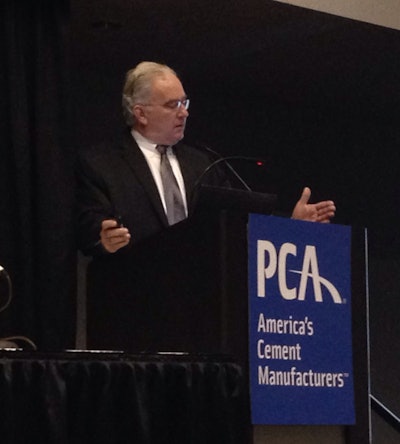 PCA chief economist Ed Sullivan speaks at World of Concrete 2014
PCA chief economist Ed Sullivan speaks at World of Concrete 2014Echoing his forecast at last year’s event—where he passed out sunglasses —during the first morning of World of Concrete 2014 Ed Sullivan, PCA chief economist, said that the conditions going into 2014 shore up his prediction for a “probably conservative” 8 percent growth in cement consumption.
Underlying factors supporting this forecast include steady and increasing job creation, the loosening of credit availability, a decreasing consumer debt burden plus improving consumer sentiment.
“At no time in our history has there been this level of pent up demand,” Sullivan says. “People have postponed major purchases such as cars and homes for such an extended period, and that provides strong consumer growth going forward.”
Although the chief fundamentals are in good shape for growth, Sullivan warns that the wildcard is still government leadership. “If Congress stays out of the way, and approves the debt limit extension without delay, then these fundamentals can create a GDP in excess of 3 percent in 2014,” says Sullivan. “Now 3 percent is certainly no huge rah-rah, but compared to what we’ve been through, it’s solid.”
The 8 percent growth in cement production will be driven by gains in all three sectors: residential, nonresidential, and even public, Sullivan says. “Anytime you get positives in all three sectors, you get extremely strong cement consumption growth. And these factors will continue to drive stronger gains in 2015 and beyond.”
Most of the gains this year will come from the residential sector, where distressed properties are no longer a market force. “Housing affordability levels are still extremely favorable and mortgage lending standards are starting to ease,” Sullivan says. “Housing starts increased 18 percent last year and will be 18 percent this year, plus double digit gains will continue through 2015. Even with all that growth, we’re not near our previous levels.”
Nonresidential is also a contributing factor, especially since vacancy rates continue to decline. The real surprise of 2014, however, will be public construction. “There are two governments involved, federal and state/local,” Sullivan says. “It’s on the state/local front that the dynamics are changing. As people begin to get jobs, they contribute to the local tax base. With more in their coffers, these governments will start to pay attention to the infrastructure in their areas that’s been neglected.”
Sullivan warns, however, these gains will be small. “We will not get back to our historical averages, in fact we may never get back to where we are 10 years ago, but there will be increases.”
PCA also announced it would no longer be known under the full name of Portland Cement Association. “There was confusion in the market among those unfamiliar with the industry as to what ‘Portland’ referred to, and many thought we were a regional organization,” says Gregory Scott, president and CEO. The organization will be known as “PCA,” with the tagline “America’s Cement Manufacturers.”














